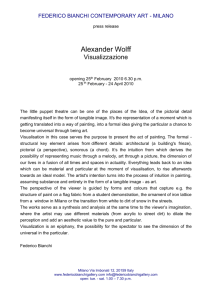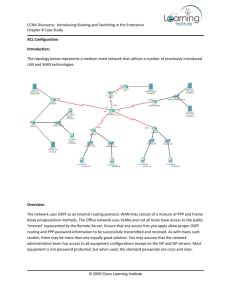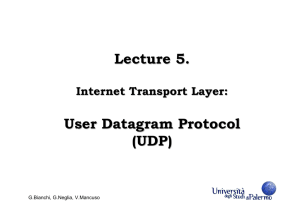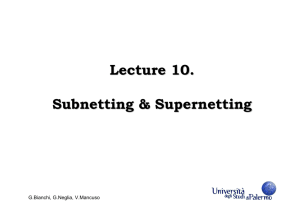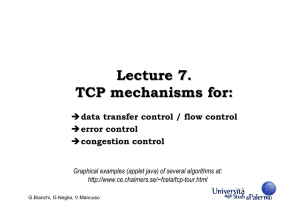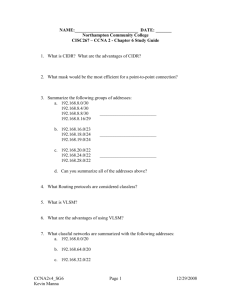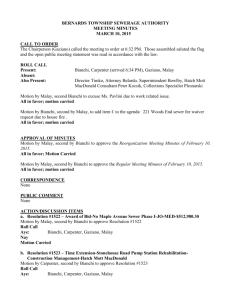Lecture 10. Subnetting & Supernetting
advertisement
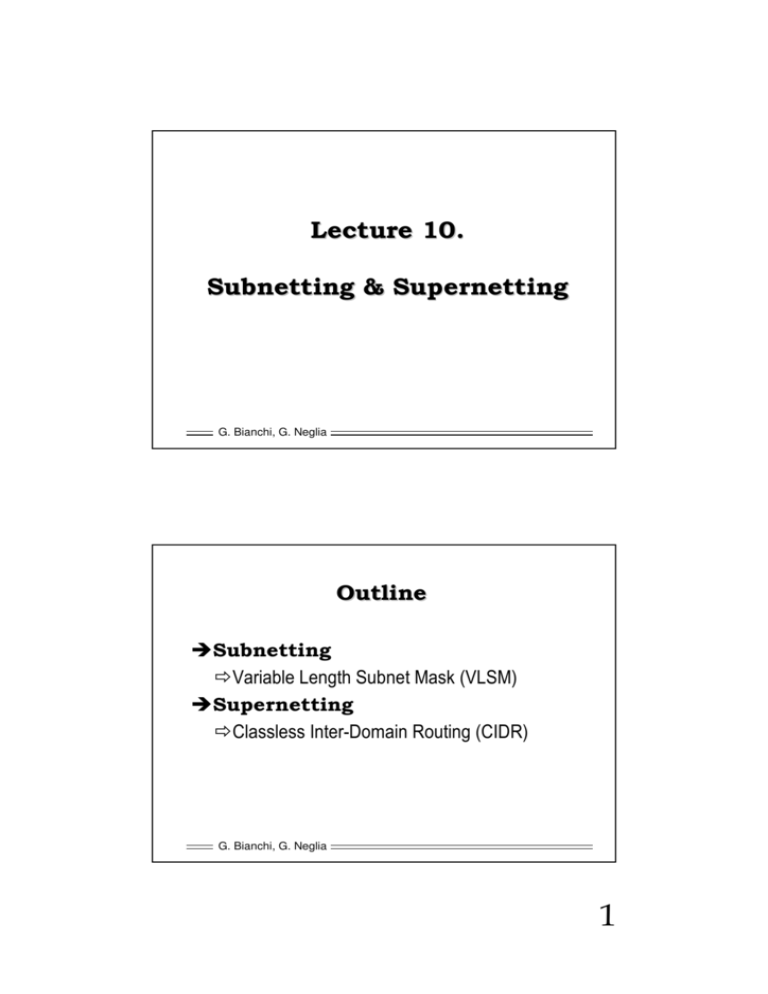
G. Bianchi, G. Neglia G. Bianchi, G. Neglia 130.11.0.7 Net 130.11.0.0 R2 R3 R2 Routing Table dest Next Hop 130.11.0.0/16 Direct fwd … … 213.2.96.0/24 130.11.0.7 213.2.97.0/24 130.11.0.7 213.2.98.0/24 130.11.0.7 213.2.99.0/24 130.11.0.7 G. Bianchi, G. Neglia !" ! 131.175.0.2 131.175.0.3 131.175.0.1 ! "# $$ % & ' & ( & G. Bianchi, G. Neglia 131.175.45.54 131.175.255.254 # $ " $ ! $% " # ! ! + , %& % & $ %& % ' () * % - ( 131.175.12.33 131.175.21.42 131.175.12.34 131.175.12.12 131.175.21.4 131.175.12.254 Router Ethernet FDDI 131.175.33.0 Host 131.175.12.0 131.175.21.1 131.175.21.0 ATM Sub-Net ! % & G. Bianchi, G. Neglia . , %/ + , * #- 01 ) * )! 131.175.12.0 131.175.12.0 131.175.21.0 131.175.21.0 ) 131.175.15.0 131.175.15.0 131.175.x.0 131.175.x.0 ! " " # $ #% & ! ' ) ( ! G. Bianchi, G. Neglia # " 2 3 1 0 -- 4 NET ID (14bit) 52 1 0 - 3 06 HOST ID (16 bit) 2 -- 4 NET ID (14bit) SUBNET ID (n bit) HOST ID (16-n bit) G. Bianchi, G. Neglia ' " $%& ( ) !# &% & ' ( * $ $ &* $ $ & & + , ) ) & & & & & & ) * , "+* "- ! - $ "./ 0 /prefix-length notation ". & . & & & & 1 &2 (dot decimal notation) 0 3 &02 2 &2 &2 . 0 3 &02 2 &1 &2 . , ( ! ! 4 " ! 0 3 &02 2 &1 &2 / 0 G. Bianchi, G. Neglia & & 4 5 & 4 *% +, - . ) network address = 131.175.0.0 natural mask = 255.255.0.0 . $ ,/0 1 0 NET ID (14bit) . ) SUBNET ID (8 bit) HOST ID (8 bit) ) * * () * * () * * (. # 131.175.21.0 * 0 3 06 6 0 - 7 06 /60 , 6 - , 0 - 4 G. Bianchi, G. Neglia 1 %2 3 45 / ! 7 $06 7 0 0 . . . . . 0 (. . . . . . . 0 (. . . . . . . 0 (. . . . . . . . ! 2 1 1 0 NET ID (21bit) 1 1 0 NET ID (21bit) Subnet (3 bit) 2 8 . 0 ) 2 4 * 6 7 0 0 . . . . . 0 (. . . . . . . 0 (. . . . . . . 0 ( 0 0 . . . . . 0 (. . . . . . . 0 (. . . . . . . 0 ( 0 0 . . . . . 0 (. . . . . . . 0 (. . . . . . . 0 ( 0 0 . . . . . 0 (. . . . . . . 0 (. . . . . . . 0 ( 0 0 . . . . . 0 (. . . . . . . 0 (. . . . . . . 0 ( 0 0 . . . . . 0 (. . . . . . . 0 (. . . . . . . 0 ( 0 0 . . . . . 0 (. . . . . . . 0 (. . . . . . . 0 ( 0 0 . . . . . 0 (. . . . . . . 0 (. . . . . . . 0 ( 6 & 2 0 3 4 G. Bianchi, G. Neglia 0 1 2 (0 (0 (. 3) 4 HOST ID (8 bit) - 5 5 5 5 5 5 5 5 ' ..... ..... ..... ..... ..... ..... ..... ..... 6 Host id (5bit) 193.1.1.0/27 193.1.1.32/27 193.1.1.64/27 193.1.1.96/27 193.1.1.128/27 193.1.1.160/27 193.1.1.192/27 193.1.1.224/27 06 6 1 1 1 1 1 1 1 1 )& 0 1 1 1 1 1 1 1 0 0 1 1 1 1 1 1 0 0 0 1 1 1 1 1 0 0 0 0 1 1 1 1 0 0 0 0 0 1 1 1 0 0 0 0 0 0 1 1 0 0 0 0 0 0 0 1 = 128 = 192 = 224 = 240 = 248 = 252 = 254 = 255 G. Bianchi, G. Neglia 3 45 / 7 193 205 / 5- 102 36 1 1 0 0 0 0 0 1 1 1 0 0 1 1 0 1 0 1 1 0 0 1 1 0 0 0 1 0 0 1 0 0 ! : 0 ! -, - 9 - 0 - network 193 host 205 102 36 1 1 0 0 0 0 0 1 1 1 0 0 1 1 0 1 0 1 1 0 0 1 1 0 0 0 1 0 0 1 0 0 ) - , - / - 255 255 255 248 1 1 1 1 1 1 1 1 1 1 1 1 1 1 1 1 1 1 1 1 1 1 1 1 1 1 1 1 1 0 0 0 ; / 0 06 -- - network -/ 0 - subnet & host 1 1 0 0 0 0 0 1 1 1 0 0 1 1 0 1 0 1 1 0 0 1 1 0 0 0 1 0 0 1 0 0 193.205.102.32 /29 G. Bianchi, G. Neglia 4 8/ . … … 162.12.0.0 193.1.1.36 … … 8 & ) … … 162.12.0.0 145.54.3.5 … … … … 162.12.0.0 145.54.3.5 … … 162.12.34.75 162.12.2.33 145.54.55.1 193.1.1.36 … 193.1.1.0 193.1.1.0 193.1.1.1 162.12.2.32 162.12.1.33 default 162.12.9.65 162.12.1.33 162.12.1.1 … 145.54.3.5 162.12.34.64 162.12.1.1 145.54.0.0 145.54.0.0 162.12.9.65 162.12.2.33 … … 162.12.0.0 193.1.1.36 … … 162.12.34.75 $ # Net = 162.12.0.0 subnet mask = 255.255.255.224 $ 8 G. Bianchi, G. Neglia 9 :9; < 1 Net = 162.12.0.0; subnet mask 255.255.255.224 + To other nets = = 162.12.1.0 > Routing Table Subnet mask: 255.255.255.224 dest Next Hop 162.12.1.0 Direct fwd 162.12.34.64 Direct fwd 162.12.35.128 162.12.34.66 162.12.70.96 162.12.1.12 131.175.0.0 162.12.34.66 131.176.0.0 162.12.34.66 default 162.12.1.11 162.12.1.1 162.12.34.65 162.12.34.64 162.12.1.12 To other subnets 162.12.70.96 162.12.70.96 162.12.34.66 May be quite a complex Routing table… VLSM will help (later) G. Bianchi, G. Neglia 162.12.1.11 162.12.35.128 162.12.35.128 To 131.175.0.0 131.176.0.0 3 9 : algebra 12 hosts A Computation 28 host Math dept 22 hosts B Link-1 physics 10 host Link-2 C G. Bianchi, G. Neglia 3 Math dept 193.1.1.96/27 up to 30 hosts (97-126) algebra 193.1.1.32/27 up to 30 hosts (33-62) B Link-1 9 A physics 193.1.1.160/27 up to 30 hosts (161-190) Link-2 C G. Bianchi, G. Neglia : Computation 193.1.1.64/27 up to 30 hosts (65-94) 3 Math dept 193.1.1.96/27 up to 29 hosts (97-126) 9 algebra 193.1.1.32/27 up to 29 hosts (33-62) Link-1 193.1.1.128/27 B Subnet mask: /27 255.255.255.224 SUBNETS: Link-2 Math 193.1.1.96/27 193.1.1.192/27 Algebra 193.1.1.32/27 Physics 193.1.1.160/27 Comput 193.1.1.64/27 Link-1 193.1.1.128/27 Link-2 193.1.1.192/27 --193.1.1.0/27 --193.1.1.224/27 G. Bianchi, G. Neglia ; ; 1< G. Bianchi, G. Neglia A 2: Computation 193.1.1.64/27 up to 29 hosts (65-94) physics 193.1.1.160/27 up to 28 hosts (161-190) C ( $ ( 4 9 4=>: ) ; $ . . == + ( $ ) ) = ? ) $ @ A Subnets may significantly vary in relative size (computer room = 200 hosts, secretary = 4 hosts…) consider a 4 host network with mask 255.255.255.0: wastes 250 IP addresses! / ! % = $ ( ( % A0 @ G. Bianchi, G. Neglia ' % A pc-net 100 host x-net-1 20 host Link-1 B Link-3 Link-2 ws-net 20 host x-net-2 10 host C < < 06 %@( < = 3 "# * $ < 2 G. Bianchi, G. Neglia & ! 0 4& 6 06 & 3 06 0)? 3= 0 - > 06 11 4 4 . $ ; ( / pc-net 192.168.1.0/25 (0-127, 126 host) 2 x-net-1 192.168.2.0/27 (0-31, 30 host) A B 192.168.2.64/27 Link-1 Link-3 192.168.2.128/27 ws-net 192.168.1.128/25 (128-255, 126 host) Link-2 192.168.2.96/27 x-net-2 192.168.2.32/27 (32-63, 30 host) C 192.168.1.0 192.168.2.0 mask 255.255.255.128 mask 255.255.255.224 G. Bianchi, G. Neglia 0 1 ) (0 6 B (0 (. 3) * ? ; ( 0)6 (pc-net) / 6 0 1 ) (0 6 B (0 (. 3) 4 )*4 ( 0 1 ) (0 6 B (0 (0 ) B 3) * 0)6 7 ( 78 ) 9 7 ( 0 1 ) (0 6 B (0 (0 ) B 3) 7 (ws-net) 2. 0 1 ) (0 6 B (0 (0 6 . 3) 7 (x1-net) 2. : " - 0 1 ) (0 6 B (0 (0 1 ) 3) B 04 (x2-net) 0 1 ) (0 6 B (0 (0 1 ) 3) 7 2. 0 1 ) (0 6 B (0 () . B 3) B 04 0 1 ) (0 6 B (0 () ) 4 3) 7 (available) 2. 0 1 ) (0 6 B (0 () . B 32 . 3 0 1 ) (0 6 B (0 () 0 ) 32 . 3 4 4 0 1 ) (0 6 B (0 () 0 6 32 . 3 4 0 1 ) (0 6 B (0 () ) . 32 . 3 , G. Bianchi, G. Neglia 4 < . $; ( $ pc-net 192.168.1.0/25 (0-127, 126 host) 255.255.255.128 A 192.168.1.208/30 Link-1 x-net-1 192.168.1.160/27 (160-191, 30 host) 255.255.255.224 B Link-3 Point2point links: 255.255.255.252 192.168.1.216/30 ws-net 192.168.1.128/27 (128-159, 30 host) 255.255.255.224 Link-2 192.168.1.212/30 C 192.168.1.0 G. Bianchi, G. Neglia #, 0 6 06 " " " 2 +! 2 A $ G. Bianchi, G. Neglia x-net-2 192.168.1.192/28 (192-207, 14 host) 255.255.255.240 1 @ ; ' ( 9 : ! " " … … … net mask route … … … ! ' ! " ( * 0 -, 27 A 0 0 & 0 - ! " $ % &' ( 6 3111 ; 0 ! # !! $ $ 1114 " ! G. Bianchi, G. Neglia 1 & pc-net 192.168.1.0/25 (0-127, 126 host) 255.255.255.128 A 192.168.1.208/30 Link-1 192.168.1.217 x-net-1 192.168.1.160/27 (160-191, 30 host) 255.255.255.224 B Link-3 Point2point links: 255.255.255.252 192.168.1.216/30 192.168.1.213 ws-net 192.168.1.128/27 (128-159, 30 host) 255.255.255.224 Link-2 192.168.1.212/30 Router C table 192.168.1.128 192.168.1.0 192.168.1.208 192.168.1.192 192.168.1.192 192.168.1.212 G. Bianchi, G. Neglia 192.168.1.216 C /27 192.168.1.213 /25 192.168.1.213 /30 192.168.1.213 /28 Direct fwd /28 Direct fwd /30 Direct fwd /30 Direct fwd x-net-2 192.168.1.192/28 (192-207, 14 host) 255.255.255.240 ; ( 0 1+ , ; , ! 7 ! 7 << ! Substantial reduction of routing table sizes Multiple route aggregation G. Bianchi, G. Neglia ; ( 0 1+ , ; , ! 7 ! << ! Substantial reduction of routing table sizes Multiple route aggregation G. Bianchi, G. Neglia 7 ! " * ! * " * #$% &% '% '( )# " + , " . - Edificio A 110 10 hosts Router R Edificio D 11 hosts Edificio B 110 55 hosts Edificio C 10 55 hosts Edificio E 12 hosts G. Bianchi, G. Neglia 8 64.2.1.128 64.2.1.64 64.2.1.48 64.2.1.0 64.2.1.16 0.0.0.0 /25 /26 /28 /28 /28 /0 Router R 64.2.100.1 … 64.2.100.2 64.2.1.64 /26 2 64.2.1.129 64.2.1.65 64.2.1.66 64.2.1.66 64.2.1.66 64.2.100.1 64.2.1.129 64.2.1.65 64.2.1.65 64.2.1.65 64.2.1.65 64.2.100.2 È sufficiente uno /24, es: 64.2.1.0 /24 Una soluzione possibile, con massima aggregazione dei route, è illustrata in figura (si assume che il routing esterno alla rete avvenga tramite l’interfaccia remota 64.2.100.1) Edificio A 110 hosts 64.2.1.129 64.2.1.128 /25 64.2.1.65 Edificio D 11 hosts Edificio B 55 hosts 64.2.1.50 64.2.1.17 64.2.1.66 64.2.1.49 Edificio C 10 hosts 64.2.1.48 /28 64.2.1.16 /28 64.2.1.2 Edificio E 12 hosts 64.2.1.0 /28 G. Bianchi, G. Neglia 8 64.2.1.128 64.2.1.64 64.2.1.0 0.0.0.0 2 64.2.1.129 64.2.1.65 64.2.1.66 64.2.100.1 /25 /26 /26 /0 64.2.1.129 64.2.1.65 64.2.1.65 64.2.100.2 È sufficiente uno /24, es: 64.2.1.0 /24 Una soluzione possibile, con massima aggregazione dei route, è illustrata in figura (si assume che il routing esterno alla rete avvenga tramite l’interfaccia remota 64.2.100.1) Edificio A 110 hosts 64.2.1.129 Router R 64.2.1.64 /26 64.2.1.128 /25 64.2.1.65 64.2.100.1 … 64.2.100.2 Edificio D 11 hosts Edificio B 55 hosts 64.2.1.50 64.2.1.17 64.2.1.66 64.2.1.49 Edificio C 10 hosts 64.2.1.16 /28 64.2.1.2 64.2.1.48 /28 Edificio E 12 hosts 64.2.1.0 /28 G. Bianchi, G. Neglia / / " * * * ! #$% &% '% '( )# " " + , " . - Edificio A 10 hosts Router R Edificio D 11 hosts Edificio B 110 hosts Edificio C 55 hosts Edificio E 12 hosts G. Bianchi, G. Neglia 8 64.2.1.128 64.2.1.64 64.2.1.48 64.2.1.0 64.2.1.16 0.0.0.0 /25 /26 /28 /28 /28 /0 2 64.2.1.129 64.2.1.200 64.2.1.49 64.2.1.200 64.2.1.200 64.2.100.1 64.2.1.129 64.2.1.129 64.2.1.49 64.2.1.129 64.2.1.129 64.2.100.2 È sufficiente uno /24, es: 64.2.1.0 /24 Una soluzione possibile, con massima aggregazione dei route, è illustrata in figura (si assume che il routing esterno alla rete avvenga tramite l’interfaccia remota 64.2.100.1) Edificio A 10 hosts 64.2.1.49 Router R 64.2.1.48 /28 64.2.1.129 64.2.100.1 … 64.2.100.2 Edificio D 11 hosts Edificio B 64.2.1.128 /25 110 hosts 64.2.1.66 64.2.1.22 64.2.1.200 64.2.1.77 Edificio C 55 hosts 64.2.1.16 /28 64.2.1.2 64.2.1.64 /26 Edificio E 12 hosts no simple aggregation! 64.2.1.0 /28 G. Bianchi, G. Neglia 1 @ ; A ( $B < . ( 9/: ' $ 8 0 6 7 )+ ? & " = G. Bianchi, G. Neglia 8 0 7 8 0 7 8 0 % 3 ( 4 ! 64.2.1.128 64.2.1.48 64.2.1.0 0.0.0.0 /25 /28 /25 /0 2 64.2.1.129 64.2.1.49 64.2.1.200 64.2.100.1 64.2.1.129 64.2.1.49 64.2.1.129 64.2.100.2 È sufficiente uno /24, es: 64.2.1.0 /24 Una soluzione possibile, con massima aggregazione dei route, è illustrata in figura (si assume che Il routing esterno alla rete avvenga tramite l’interfaccia remota 64.2.100.1): Edificio A 10 hosts 64.2.1.49 Router R 64.2.1.48 /28 64.2.1.129 64.2.100.1 … 64.2.100.2 Edificio D 11 hosts Edificio B 64.2.1.128 /25 110 hosts 64.2.1.66 64.2.1.22 64.2.1.200 64.2.1.77 Edificio C 55 hosts 64.2.1.16 /28 64.2.1.2 64.2.1.64 /26 Edificio E 12 hosts 64.2.1.0 /28 G. Bianchi, G. Neglia 3 ; B"$C 06 ( # 7 7 7 7 7 7 7 7 7 7 7 7 7 7 7 7 7 7 7 7 7 7 G. Bianchi, G. Neglia 1 . $; ( 7 7 8 0 7 7 # 8 0 7 7 % 7 7 7 ) 7 7 7 8 0 ! 7 8 0 7 7 7 7 7 G. Bianchi, G. Neglia 1< #C1 # !C 1 7 > 7/ 9 445: G. Bianchi, G. Neglia ! 7 7 7 7 ' $ & 130.11.0.7 R2 Net 130.11.0.0 R3 R2 Routing Table dest Next Hop 130.11.0.0 Direct fwd … … 213.2.96.0 131.11.0.7 213.2.97.0 131.11.0.7 213.2.98.0 131.11.0.7 213.2.99.0 131.11.0.7 G. Bianchi, G. Neglia *$ 44/ # ( In early years, Class B addresses given away! Inefficient division into A, B, C classes byte-word: unwise choice (class C too little, class B too big) The aftermath: much better, e.g. C=10 bits, B=14 bits Projections at the time: class B exhaustion by 1994/95 $ % : G. Bianchi, G. Neglia < == *$ $ $% 0 . ) 9 7 : $C ( A D ! %B 0 #6 )*4 . ) 7 7 7 D $% $ G. Bianchi, G. Neglia 1 . $ 130.11.0.7 Net 130.11.0.0 R2 2 R3 ) R2 Routing Table G. Bianchi, G. Neglia dest Next Hop 130.11.0.0 /xx Direct fwd … … 213.2.96.0 /24 131.11.0.7 213.2.97.0 /24 131.11.0.7 213.2.98.0 /24 131.11.0.7 213.2.99.0 /24 131.11.0.7 *$ 44/ # Multiple class C allocation dramatic for routing tables necessary because of Class B exhaustion 100.000 entries highly critical for performance » 2M class C: WAY OUT of the capabilities of routing sw & hw Projections at the time End 1990: 2190 routes; end 1992: 8500 routes; End 1995 projection: 70000 routes (critical); End 1995 factual: 30000 routes thanks to classless routing Mid 1999: 50000 routes G. Bianchi, G. Neglia ( ) 11.0.0.32 Net 11.0.0.0 20.0.0.5 R1 20.0.0.6 130.11.0.12 130.11.0.7 Net 20.0.0.0 R2 Net 130.11.0.0 R2 Routing Table Destination Network Next Hop 20.0.0.0 Direct forward 130.11.0.0 Direct forward 11.0.0.0 20.0.0.5 213.2.96.0 130.11.0.7 213.2.97.0 130.11.0.7 213.2.98.0 130.11.0.7 213.2.99.0 130.11.0.7 G. Bianchi, G. Neglia * + 213.2.96.8 R3 213.2.99.5 Default routes: suboptimal traffic balancing Core routers: cannot have default routes (large tables) HW and SW limits on routing table lookup time Routing table updates are critical (large tables traveling among routers for updates) # !C #C1 3 ' 6 % 0 0> 70 01 70 03 70 !5 ) 1 %%4 2 + 6 ! 32 bits: unwise choice nobody could expect such an Internet growth and Internet appliances will have a terrific impact unwise address assignment in early days class B addresses with less than 100 hosts are common!! Projections (RFC 1752): address depletion between 2005 and 2011 Ultimate solution: IPv6 (128 bits address!) G. Bianchi, G. Neglia #C1 = . + %/ ) = > C ! =C " ! % # D" 3# " ( (/ E A 4 #C1 + ; 22 G. Bianchi, G. Neglia = =C ( $ #C1 10.23.64.0/20 00001010.00010111.01000000.00000000 130.5.0.0/20 10000010.00000101.00000000.00000000 200.7.128.0/20 11001000.00000111.10000000.00000000 , $ . !! ! !"! * ) - !! + " 7 & ! " $ )* . " 5 * 5 ( A : 8 D / / 0/ 0 0 6 ! -- G. Bianchi, G. Neglia #C1 + : E - ! -- ! -- &0 6 = 1# $! F - F ! / "! * + * 1 1 1 1 1 1 1 1 3$ 0 0 * ! 1 1 1 1 1 1 1 1 4 G. Bianchi, G. Neglia + & 1 1 1 1 1 1 00 0 0 0 0 0 0 0 0 ' 0 ! . 213.2.96.0 213.2.97.0 213.2.98.0 213.2.99.0 ) 11010101.00000010.01100000.00000000 11010101.00000010.01100001.00000000 11010101.00000010.01100010.00000000 11010101.00000010.01100011.00000000 ) ) * * () * * () * ) (. / 5 / 4- ,// G. Bianchi, G. Neglia 1 11.0.0.32 Net 11.0.0.0 20.0.0.5 R1 . $ #C1 20.0.0.6 130.11.0.12 130.11.0.7 Net 20.0.0.0 R2 Net 130.11.0.0 R2 Routing Table Dest.Net Dest.Netmask Next Hop 20.0.0.0 255.0.0.0 Direct forward 130.11.0.0 255.255.0.0 Direct forward 11.0.0.0 255.0.0.0 20.0.0.5 213.2.96.0 255.255.252.0 130.11.0.7 R3 213.2.99.5 Corporate Supernet address: 213.2.96.0/22 11010101 . 00000010 . 011000 00 . 00000000 G. Bianchi, G. Neglia 213.2.96.8 ) * + . ) % Organization assigned 2n class C addresses may arbitrarily deploy subnetworks with more than 254 hosts! This was impossible with class C, as natural netmask was /24 BUT Software running on all the subnet hosts need to accept larger masks than natural one e.g. setting netmask = 255.255.252.0 for host IP address 193.21.34.54 may be forbidden by sw G. Bianchi, G. Neglia 1 @ 8 #C1 ? *8 Routing protocol must carry network prefix information with each route advertising all routers must implement a consistent forwarding algorithm based on the “longest match” for route aggregation to occur, addresses must be assigned to be topologically significant G. Bianchi, G. Neglia 1 . $ $! ( ( 2 3 42 / 7 ) " )$ + 7 7 7 7 7 7 7 7 7 7 # ! 7 7 7 7 7 7 ! % 7 7 7 ! 7 7 ! ! ? G. Bianchi, G. Neglia #C1 ! C 0 50 : * # ! $ 0 + # 8 : : )# * # , - # ! 6 8 3 -- / - &H G. Bianchi, G. Neglia % 6 I 0 0 7 & -G # -4 $ . )+ ? & 8 0 11001011 . 00010110 . 01000010 . 00000101 6 7 8 0 7 8 0 7 R1: 11001011 . 00010110 . 01000010 . 00000101 R2: 11001011 . 00010110 . 01000010 . 00000101 R3: 11001011 . 00010110 . 01000010 . 00000101 " % ( 8 0 3 4 38 4 = 5 * ! $ " ( 666 G. Bianchi, G. Neglia 3 A $ , D 0 1 * (. () . () 0 0 . . . . 0 0 (. . . . . . . . (. . . . 0 0 . . (. . . . . . 0 . 194.0.0.0 /7 (254.0.0.0) 0 0 . . . . 0 . (. . . . . . . . ( . . . . . . . . ( . *J 8: @(58 + # 8 )$ 8: @(58 " $ 7 0 195.0.16.0 /21 ' 0 0 0 . . . . 0 0 (. . . . . . . . ( . . . . 0 . . . ( . " G. Bianchi, G. Neglia , 0 E 0 K " 7 ( )$ + 3# 6 4 7 ) : 7 )$ + 35 0 E # 4 At a point in time, organization A selects Eunet as new ISP! / = D ! = " = C ? - and even think to organizations that re-sells subnets... G. Bianchi, G. Neglia 7 ( )$ + 3# 6 4 ) : 7 )$ + 35 0 7 4 E # 7 Then organization A keeps the same address block Eunet is in charge to advertise the new block, too, by injecting in the internet more specific route infos This has created a new entry in routing tables, to be solved with longest match G. Bianchi, G. Neglia *$ #C1 & + ( !5 $ " % % #@ ' $ ! A B C *& < Address ownership (portable blocks): dramatic » » Proposals (not accepted) to allows ownership only up to /9 ISPs Current “rule”: ownership starts from 8192 host networks (/19) Address lending » Renumbering necessary when changing ISP 4& + !# D #E unlikely, as they are viewed as assets!! ' 6 % 03 0> G. Bianchi, G. Neglia ' ) 91< & 4 =: # IANAIANA-Allocated, Allocated, NonNon-Internet Routable, Routable, IP Address Schemes ( * @ Class Network Address Range A B C 10.0.0.0-10.255.255.255 172.16.0.0-172.31.255.255 192.168.0.0-192.168.255.255 6 0 - 6 , * E )# * # # -- G. Bianchi, G. Neglia ) ( * )! ) -2 , - - . )' * “Inside” Network “Outside” Network NAT 10.0.0.2 10.0.0.2 192.69.1.1 Internet 10.0.0.3 Source Address NAT Table Inside Local IP Address Inside Global IP Address 10.0.0.2 10.0.0.3 192.69.1.1 192.69.1.2 ( . $# 9 % : G. Bianchi, G. Neglia #6&9#6 ! #6 : *$ 0)B " " A "4 although mostly designed to be as close as possible to IPv4 6 % A == G. Bianchi, G. Neglia ? ! 4. = " A "4 ). A "6
